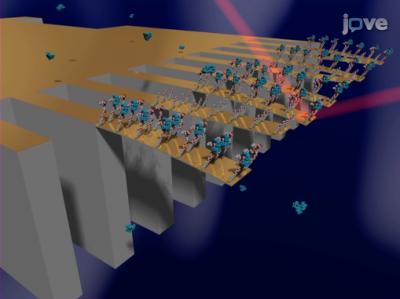On October 25, JoVE, the Journal of Visualized Experiments will publish a novel technique to confront the problem of antibiotic resistance. According to Dr. Joseph Ndieyira, one of the developers involved in the technique, “The use of this technology will allow scientists to understand how antibiotics work, how bacteria develop resistance, and what molecular mechanisms could be exploited to get around their defense mechanisms.”
“We report a novel, nanomechanical approach to investigate the workings of vancomycin … one of the last powerful antibiotics used to combat increasingly-resistant infections such as methicillin-resistant Staphylococcus aureus (MRSA),” said Ndieyira.
Using tiny cantilevers (or beams) no wider then a human hair, Ndieyira and his colleagues take advantage of the cellular stress that antibiotics, when effective, impose on a target bacteria’s cell wall. Such stress in turn causes the cantilevers to bend. Using lasers, the bending can then be measured—providing tremendous insight into the drug-target interaction.
According to Ndieyira, the cantilever technology confronts a growing problem of multidrug-resistant hospital superbugs. It could aid in the drug discovery process by preventing lead-drug candidates from being disregarded due to a lack of equipment with sufficient sensitivity, and its hope is to jumpstart an already stagnated drug-pipeline by providing this sensitivity in an efficient manner—the cantilever method can simultaneously measure and track a variety of drug-bacteria interactions in real time.
“The cantilever assays provide a resolution that simply cannot be obtained with conventional methods, such as those using fluorescence,” said Ndieyira, “For example, cantilever sensors can resolve forces of ~10 pN, which is sensitive enough to detect the rupturing of individual hydrogen bonds.” According to the article, a single hydrogen molecule can be the difference between drug-susceptible and drug-resistant bacteria.
The cantilever technique is currently under review in the science journal Nature for its clinical use in a microchip. “This prototype will provide a platform for more sensitive measurements, enabling results in early detection of infectious diseases, rapid identification of a host of new biomarkers, and for the engineering of portable diagnostic tools,” said Ndieyira. He also described the technique as a possible alternative for drug experimentation on animals.
When asked why he and his colleagues decided to publish their technique through video, Ndieyira said, “JoVE is the only journal that provides a unique and powerful opportunity to communicate my latest measurements and procedures visually, thus making it easy and effective for others to replicate the experiment.”


